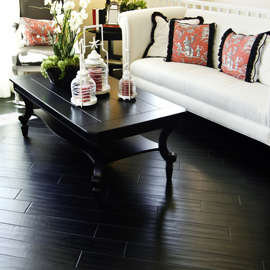Information About Flooring
RELATIVE HARDNESS OF SELECTED
WOOD FLOORING SPECIES
(Ranked by Janka hardness rating)
If you’re interested in installing hardwood flooring or parquet floors, then take the time to learn more information about the flooring at Zoltan European Floors, Inc.
The Janka (or side) hardness test measures the force required to embed a .444-inch steel ball to half its diameter in wood. It is one of the best measures of the ability of a wood species to withstand denting and wear. By the same token, it is also a good indicator of how hard or easy a species is to saw or nail. Northern red oak, for example, has a Janka hardness rating of 1290. Brazilian cherry, with a rating of 2350, is nearly twice as hard. If you’re accustomed to working with red oak and decide to tackle a job with Brazilian cherry, you can expect it to be much harder to cut or nail.
SPECIES |
RATING |
| Rosewood | 3170 |
| Brazilian cherry | 2350 |
| Mesquite | 2345 |
| Santos Mahogany | 2200 |
| Merbau | 1925 |
| Jarrah | 1910 |
| Purpleheart | 1860 |
| Hickory/Pecan | 1820 |
| African padauk | 1725 |
| Wenge | 1630 |
| Hard Maple | 1450 |
| Australian cypress | 1375 |
| White oak | 1360 |
| Ash | 1320 |
| American beech | 1300 |
| Red oak (northern) | 1290 |
| Yellow birch | 1260 |
| Heart pine | 1225 |
| Black walnut | 1010 |
| Ash | 1320 |
| Teak | 1000 |
| Black cherry | 950 |
| Yellow birch | 1260 |
| Southern yellow pine (longleaf) | 870 |
| Douglas fir | 660 |
RELATIVE STABILITY OF SELECTED
WOOD FLOORING SPECIES
(Ranked by dimensional change coefficient)
 The numbers in the chart reflect the dimensional change coefficient for the various species, measured as tangential shrinkage or swelling switching normal moisture content limits of six to 14 percent. Tangential change values will normally reflect changes in plainsong wood. Quartersawn wood will usually be more dimensionally stable than plainsawn.
The numbers in the chart reflect the dimensional change coefficient for the various species, measured as tangential shrinkage or swelling switching normal moisture content limits of six to 14 percent. Tangential change values will normally reflect changes in plainsong wood. Quartersawn wood will usually be more dimensionally stable than plainsawn.
The dimensional change coefficient can be used to calculate expected shrinkage or swelling. Simply multiply the change in moisture content by the change coefficient, then multiply by the width of the board.
Example: A mesquite (change coefficient = .00129) board five inches wide experiences a moisture content change from six to nine percent — a change of three percentage points.
Calculation: 3 x .00129 = .00387 X 5 = .019 inches
In actual practice, however, change would be diminished in a complete floor, as the boards’ proximity to each other tends to restrain movement.
The chart is best used for comparison.
* Although some tropical woods such as Australian cypress, Brazilian cherry, merbau and wenge appear in this chart to have excellent moisture stability compared to domestic oak, actual installations of many of these woods have demonstrated significant movement in use. To avoid problems later, extra care should be taken to inform potential users of these tendencies prior to purchase.
SPECIES |
RATING |
| American beech | .00431 |
| True hickory | .00411 |
| Jarrah | .00396 |
| Red oak | .00369 |
| White oak | .00365 |
| Hard maple | .00353 |
| Yellow birch | .00338 |
| Pecan | .00315 |
| Brazilian cherry* | .00300 |
| White ash | .00274 |
| Black walnut | .00274 |
| Douglas fir | .00267 |
| Southern yellow pine | .00265 |
| Heart pine | .00263 |
| Black cherry | .00248 |
| Santos mahogany | .00238 |
| Purpleheart | .00212 |
| Wenge* | .00201 |
| Teak | .00186 |
| Ash | 1320 |
| Teak | 1000 |
| Padauk | .00180 |
| Australian cypress* | .00162 |
| Merbau* | .00158 |
| Mesquite | .00129 |





